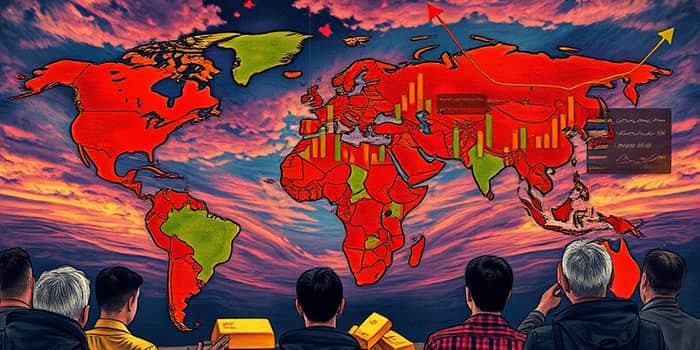
Global markets today exist in an era defined by shifting alliances, armed conflicts, and economic pressure. Understanding how these forces shape asset prices is crucial for investors and policymakers alike.
Geopolitical risk refers to the uncertainty and financial disruption arising from wars, terrorism, and political tensions. It encompasses the threat, realization, and escalation of adverse events that can derail international trade and economic stability. These events may be direct—such as military actions and sanctions—or indirect, through heightened market volatility and inflationary pressures.
Key factors include armed conflict, diplomatic disputes, social unrest, trade wars, and terrorism. Each of these elements can transmit shocks across borders, creating ripple effects that alter investor sentiment and capital flows.
Over the past 120 years, research shows that major geopolitical risk events lead to significant declines in banking capitalization, later depress GDP growth, and cause asset price contractions. However, the magnitude of the impact varies greatly by region and economic structure.
Some landmark episodes include the First Gulf War in the 1990s, the 9/11 terrorist attacks in 2001, and recent surges such as the Russian invasion of Ukraine (2022 onward), Middle East conflicts, and US-China trade tensions. In each case, markets responded unevenly, reflecting differences in exposure and resilience.
Geopolitical risk distorts asset prices through several channels:
Sectors exposed to raw materials and trade tend to experience the largest swings when geopolitical risk rises. Conversely, defensive industries like health care and utilities often show resilience.
Emerging markets are generally more vulnerable to capital flight and currency weakness, while developed safe-haven markets often benefit from inflows seeking refuge.
Analysts gauge geopolitical risk through media-based indices and market volatility measures. For example, the Caldara-Iacoviello Geopolitical Risk Index tracks news coverage intensity, while correlations and volatility spikes in asset prices reveal real-time stress.
Historical analysis demonstrates that during high-risk periods, expected equity returns fall sharply and forecast volatilities climb above levels predicted by standard models like the VIX.
Russia-Ukraine War (2022-2024): European gas and oil prices spiked over 50% year-over-year. Equity markets in Europe and emerging Europe lagged by 10–15%, while US defense stocks outperformed by roughly 8%.
Middle East Conflict (2024): Houthi attacks in the Red Sea increased shipping costs by 20%, leading 40% of surveyed firms to report direct supply chain losses.
US-China Trade Tensions (2023-2025): Tariff announcements coincided with 7% swings in consumer electronics stocks and shifts in regional production hubs toward Southeast Asia.
Investors can manage geopolitical risk through disciplined diversification across asset classes and geographies. Hedging strategies—including commodity futures and currency options—serve as effective shields. Many are also integrating environmental, social, and governance resilience factors into their frameworks.
Corporates must bolster governance by embedding crisis protocols, stress-testing supply chains, and maintaining liquidity buffers. Boards play a critical role in monitoring external threats and guiding management responses.
Looking ahead to 2025, over 58% of corporations expect trade wars to weigh negatively on financials, mirroring concerns from the Russia-Ukraine conflict. Meanwhile, nearly 40% anticipate further supply disruptions from Middle Eastern tensions.
Asset price volatility is likely to remain elevated, with emerging markets and resource-dependent sectors carrying a higher risk premium. Central banks may keep policy rates above pre-pandemic norms, and macroprudential supervision will be vital to contain systemic stress.
Geopolitical risk is an enduring and evolving force shaping global asset prices. From historical shocks to modern trade wars, its fingerprints are found across markets, sectors, and regions. By understanding the mechanisms at play and adopting robust risk management strategies, investors and policymakers can navigate uncertainties with greater confidence and resilience.
References













